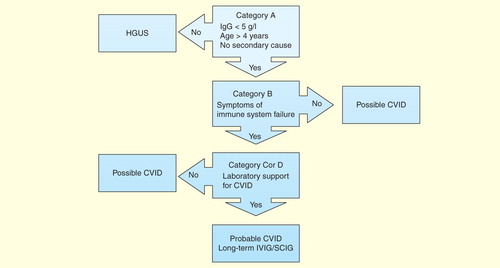Figures & data
Table 1. Proposed diagnostic criteria for common variable immune deficiency.
Figure 1. Diagnostic and treatment algorithm for common variable immune deficiency. Patients must meet all major criteria in Category A for consideration of CVID. Category B confirms the presence of symptoms indicating immune system failure. To have probable CVID, patients must also have supportive laboratory evidence of immune system dysfunction (Category C) or characteristic histological lesions of CVID (Category D). Patients with mild hypogammaglobulinemia (IgG >5 g/l) are termed hypogammaglobulinemia of uncertain significance (HGUS). Patients meeting Category A criteria but not other criteria are deemed to have possible CVID. Most patients with probable CVID are likely to require IVIG/SCIG. Some patients with possible CVID will require IVIG/SCIG, but most patients with hypogammaglobulinemia of uncertain significance are unlikely to need IVIG/SCIG replacement.

